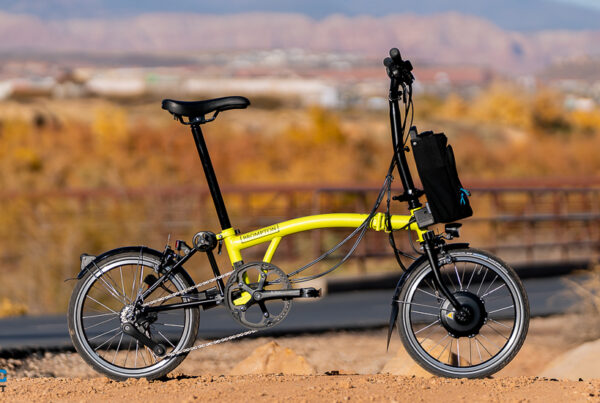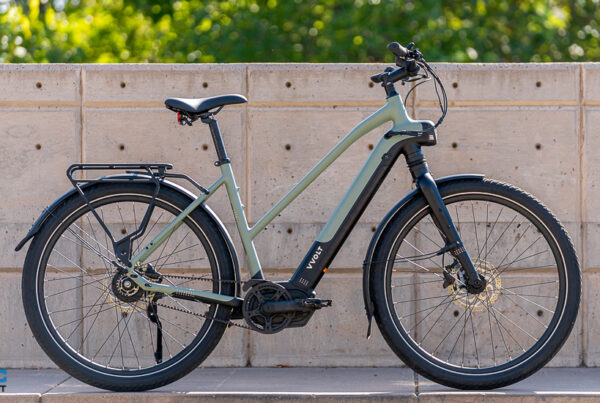Some links may be affiliate links. We may get paid if you buy something or take an action after clicking one of these.

– Confused by the pros and cons of derailleurs, hub gears and continuously variable transmission? We demystify all of this down below. –
A lot of e-bike publicity focuses on the performance capabilities of the motor or the size of the battery. One often-overlooked area is gearing.
Surely you just get the same choice as on a regular bike? Only to a point; the e-bike revolution has meant many things for e-bike design, one of which is an expansion of the gearing options available.
With extra motor power available bigger and better-performing gears can be used, gears which would be too heavy or difficult to pedal for most riders of non-electric bikes. These are covered in the Advanced Systems section dow below.
But for now, let’s stick with gearing systems 101: derailleurs and hub gears
The Basics: Derailleur and Hub Gears
The majority of e-bikes are equipped with derailleur gears, with hub gears being the major alternative choice. Both options go back many, many decades so the technology on both is well advanced and should work well for its intended purposes. But what are they and what are the pros and cons of each system?
Derailleur Gears: Overview

Derailleur gear set ups are so named as they always consist of a derailleur (or rear mech) in black here and a rear cassette (or rear cogs) which is the array of silver coloured sprockets. Some bikes use a front derailleur too (see infographic below) but front derailleurs are very rare on e-bikes.
Derailleur gears are external, with a rear derailleur usually connected to a cable. Tensioning the cable via a shifter on the handlebars means the derailleur guides the chain up over the sprockets onto the larger, easier to pedal ones (lower gears) ideal for hillclimbing. Letting the tension off in the cable means the spring in the derailleur pulls the chain downwards and outwards onto the smaller, harder to pedal gear sprockets (higher gears) for traveling at speed.
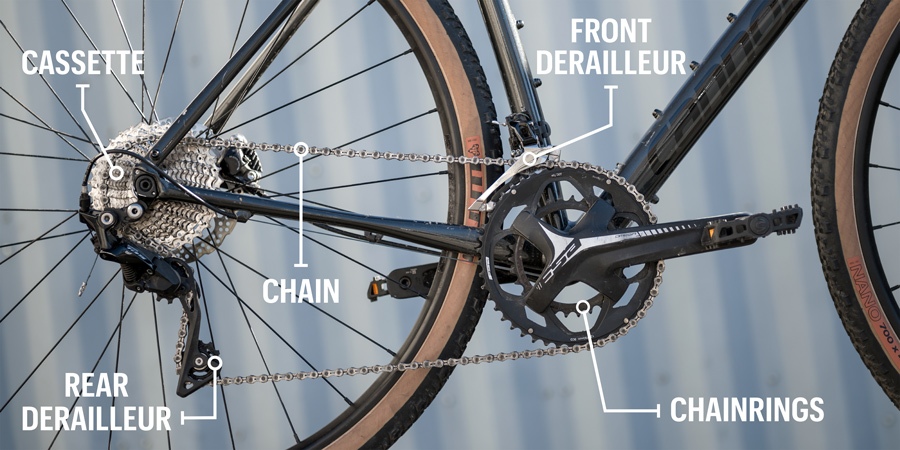
Terminology of the parts commonly found on derailleur systems
Common derailleur gear makes found on e-bikes are Shimano and SRAM.
Pros of Derailleur Gears:
- They are lightweight systems, and at the budget end of the market they are cheap to replace if damaged.
- Said to be more efficient than internal hub gears.
- Derailleurs give a wide range of gearing options (ie very low gears for easy hill climbing and high gears for speed on the flat and downhill).
To add a little more color to that last point: recent decades have seen the development of a relatively simple form of wide range gearing using only a single chainwheel at the front of the chain and a very wide range of gears on the rear cassette.
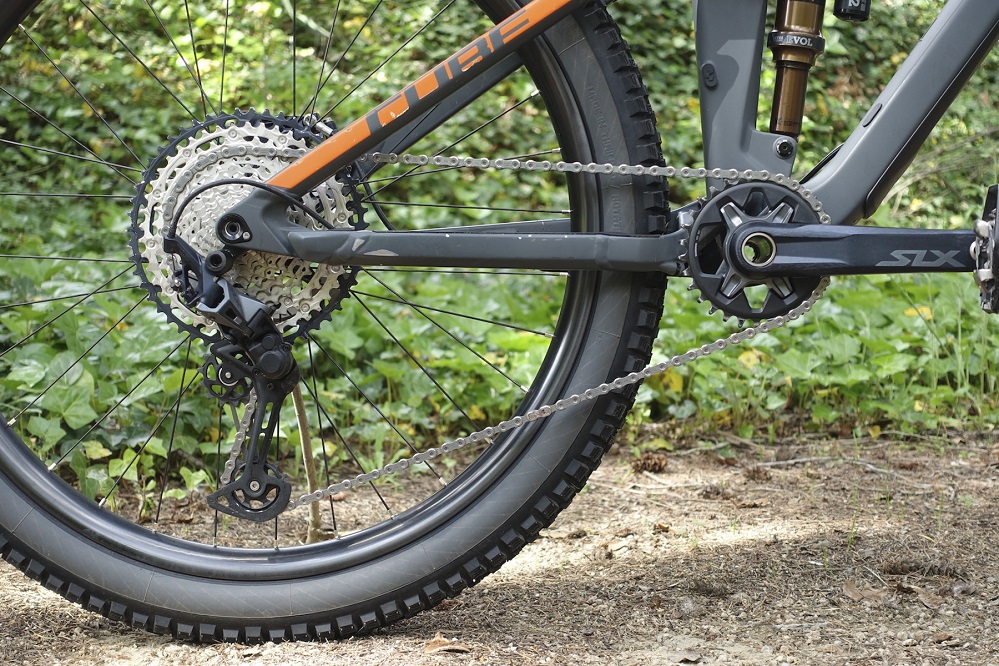
A 1 x 12, wide-range derailleur gear set up from Shimano – in this instance on a high performance, sporty Cube eMTB
The number of teeth are often given in derailleur gearing specs. For example, on a high-quality mountain bike setup you might see something like ‘Front Chainring 36T Rear Cassette 11-50T’ – T here indicating the number of teeth.
This kind of setup means ‘low gearing’ – ie easy to pedal on off-road surfaces where there is more resistance and where you will want to tackle really steep terrain.
Note the lower the number of teeth on the front chainring the easier a bike is to pedal whilst larger gear sprockets in the rear derailleur mean easier pedaling.
By contrast, a gear setup on a typical urban bike might feature a 40T front chainring and an 11-34T rear cassette, giving a narrower, higher geared range of gears suitable for typical town riding conditions.
Cons of Derailleur Gears
- Not advisable to change whilst stationary or to change through many gears in one shift.
- Open to the elements so prone to getting dirty and so becoming noisy and harder to shift.
Due to the open design, they need pretty regular cleaning and maintenance.
Sticking out near the ground as they do, derailleurs can be prone to damage too, though it normally needs a pretty severe impact to cause damage so it certainly shouldn’t be a regular occurrence.
Having said all this they are relatively easy for the user to maintain themselves compared to hub gears.
Hub Gears: Overview
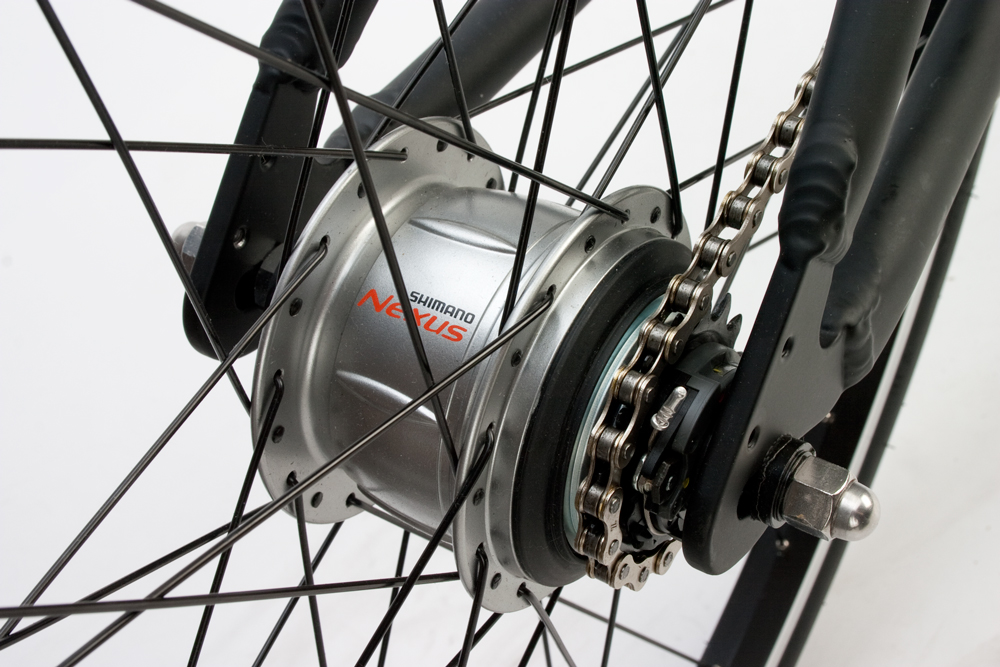

Riese & Muller full suspension emtb with Rohloff hub gear
In terms of numbers of gears the Rohloff system is the granddaddy of all hub gear systems with its 14 gears, but note it is quite heavy and very expensive. It does feature in a number of go-anywhere style e-bikes, including many in the Riese & Muller range, proving there’s no real reason you can’t fit the right hub gear to just about any kind of e-bike.

Rohloff hub gear with belt drive
Like derailleurs, hub gears have distinct pros and cons.
Pros of Hub Gears:
- Low maintenance. As the gears are not exposed to the elements they can usually be left to run for a few thousand miles without much attention. Your chain should also last longer as it is not constantly being moved between different gear cogs.
- Can be shifted over several gears at a time and when stationary – ideal features for stop-start riding in towns
- If you are looking for a belt drive e-bike rather than a chain drive one you will need a hub geared bike as derailleurs do not work with belt drives.
- Great for riding in all conditions as they are sealed from the elements.
Cons of Hub Gears:
- Usually heavier than derailleurs gears and more expensive, especially for the systems with more gears.
- If something does go wrong inside the hub it’s generally a job for an expert (though this is very rare and on the flip side reliability is generally a reason for choosing hub gears).
- You get the option of a ‘back pedal’ coaster or fully enclosed drum brake with some hub gears though these options are much more common in continental Europe than the UK and the US.
- Often less range than a wide range derailleur system, though note Shimano’s 11 speed setup an Rohloff’s 14 speed hub gears will come close to or exceed many derailleur gear setups in the range they offer.
- Can be harder to remove the rear wheel (for mending a flat, maintenance etc) compared to a derailleur system.
Which Is Better: A Derailleur or Hub Gear System?
The internet is full of arguments about which are better – derailleur or hub gears.
The answer is a very simple one: it depends. It comes down to your kind of cycling and what derailleur or hub gear your e-bike is running.
As a very general rule hub gears and cheaper narrow range derailleurs are used for town bikes and derailleur gears for more sport-oriented e-bikes i.e. e-road bikes or those going off-road.
Here’s a useful recap video on derailleurs and hub gears.
Advanced E-Bike Gearing Systems
Electronic & Wireless Shifting
Electronic shifting was first introduced for road riders to be able to get faultless, precise gear shifts on derailleur gear systems in an attempt to make their road bikes run as smoothly and therefore as quickly as possible when going through the gears.
In essence, there are no cables between your handlebars and the gears as there would be on a traditional system and a small motor changes makes the change. On manual systems this is done when you press a button on the handlebars, sending an electronic system down a wire (or alternatively wirelessly) to the control at the gears.
As these systems have sensors built into them they claim to be able to offer more precise shifting and to be able to calibrate themselves; traditional gear systems can suffer from things like cable stretch, knocks and bumps and just wear and tear that means the gears can sometimes skip between each other when you don’t want them to or fail to change gear at all when you do make a gear change on the handlebars.
Normally a little maintenance cures these problems, but electronic changing claims this should not happen.
As this is a relatively new technology it has taken a while for motor manufacturers like Bosch and gear manufacturers like Shimano to get together and integrate the latest motor systems with the latest electronic gears.
Here’s a pictorial demonstration of how Shimano’s electronic Di2 system works with Bosch mid motors. If you are interested in this system we recommend an extended test ride to test if it works for your style of riding.
Bosch mid-drives also work with Rohloff and Enviolo (see below) electronically shifting hub gears.
Continuously Variable Transmission (CVT): Overview
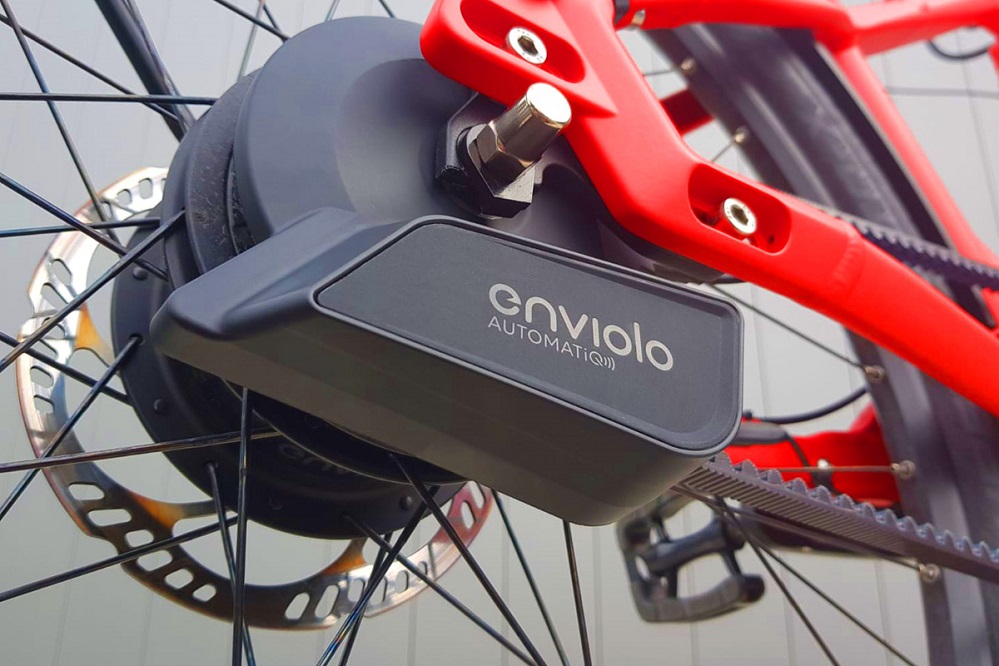
CVT gear systems are recognisable by the large rear hub. This one has a large automatic shifting device on it.
Continuously variable transmission is a long-phrase for a very simple concept – there are no set number of gears on a CVT system, rather as you twist a handgrip or press a button the gearing simply moves up and down the range – it’s impossible to get out of gear and have the pedals spinning around like crazy, as can happen on conventional systems (especially hub gears), as the system is always in gear.
There are of course, as with any bike technology, pros and cons:
Pros of Continuously Variable Transmissions:
- Ease of use – just turn the twistgrip or press the buttons on the handlebar control to select how hard or easy to pedal you want the e-bike to be. That’s it!
- Low maintenance
- There is an automatic option that means you don’t even have to move the twistgrip or press buttons, the system will change gear for you.
Cons of Continuously Variable Transmissions:
- Relatively heavy and there is certainly more pedal resistance than on other gear systems.
- Pricier than other options
Remember, e-bikes are suited to this type of gearing as the motor power means you don’t notice the extra resistance so much. However, it will mean a little less range on your battery as the electric assist system has to work harder to overcome the extra resistance.
Again, Bosch’s mid drives will interface with this system:
Bottom Bracket Gearing: Overview
It’s also possible to put the gearing around the pedal axle. Clearly this won’t work with mid-drives as this is where the motor sits, but bottom bracket gearing specialist Pinion have come up with this very sophisticated looking system that works with a rear hub motor.
The main advantage of this system is that the motor power does not go through the gears and so reduces wear and tear and stress on them. Just like other enclosed gear systems it will add weight compared to derailleur systems and may not be as efficient.

German company Tout Terrain specialise in this kind of gear and motor setup and it certainly looks extremely robust and reliable for ‘workhorse’ type e-bike tasks.
So How Many Gears Do You Need On Your E-Bike Gearing System?
After we’ve said all this don’t get too hung up on what gears are required – adding motor power actually makes having lots of narrowly spaced gears (as found on traditional road racing bikes for example) less important. EBR has boiled it down to these four points.
- The easier your terrain – both in terms of hills and surface underwheel – the fewer gears you need. For flat city riding you might even want to consider the ultimate in simplicity and low maintenance: a single speed e-bike.
- For steep riding off-road over challenging terrain choose plenty of gears and make sure they have a wide range. Gear range – the difference between the lowest and highest gears – is often expressed as a percentage. Over 500% can be considered a very wide gear range and 300% around average and one that should enable you to tackle quite a large variety of terrain.
- Hub gears are best for low maintenance ‘utility’ style riding where the weight of the e-bike is not too important. As sporty performance and lightweight become more important you will probably lean towards a derailleur setup (though note the use of the Rohloff on some off-road e-bikes). Hub gears are probably also easier and more intuitive to use for e-bike newbies.
- Of all the so-called ‘advanced systems’ covered above the Enviolo CVT is probably the one most suited to absolute e-bike newbies as it is so easy to use, whilst electronically shifting options can be considered both as a low maintenance and a sporty option, depending on the particular setup. Automatic gearing is still an emerging technology so EBR strongly recommends a test ride on one of these systems before buying to check if it really suits you.
Stay tuned for more e-bike news and reviews and thanks for reading!
-Rich
Related
Reader Interactions
![]()
Source link







